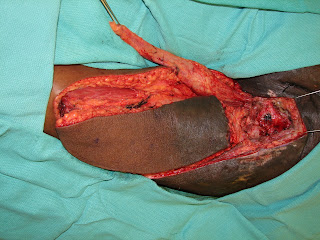Exposure to carcinogens can cause cancers of the lower lip. If these cancers are not addressed in a timely fashion, the cancer can replace the substance of the lower lip almost entirely. Surgical removal of these tumors requires total lower lip excision and bilateral neck dissection.
Large defects such as this one can not be closed primarily, by bringing the two open edges of the lower lip together. In addition, it is important to restore oral lining to the inside of the mouth. A large amount of tissue that is brought into this area requires a blood supply sustain the viability of the tissue.
The skin, fat, and fascia on the medial aspect of the forearm is thin and pliable to conform to defects of the lower lip and oral lining. The arterial supply of the forearm is derived from the radial artery and the venous drainage is served by the cephalic vein. When incorporated properly, the palmaris longus can be used as a sling to provide oral competence.
The photograph below demonstrates from top to bottom, the cephalic vein, the radial artery, the palmaris longus tendon, and the medial antebrachial cutaneous nerve.
Appropriate inset of the flap requires microsurgical anastamosis of the flap vessels to the vesesls of the neck. The palmaris longus tendon is sutured to the modiolus and the malar eminence. The radial artery is anastamosed to the facial artery and the cephalic vein is anastamosed to the external jugular vein.
Post-operatively, nutrition is provided by tube feeding to prevent trauma to the suture lines.
http://www.drbriandickinson.com/



























